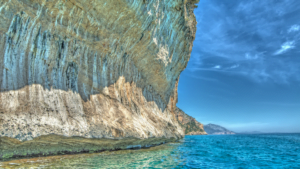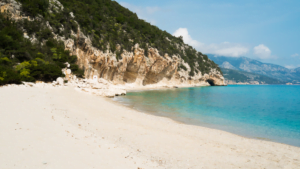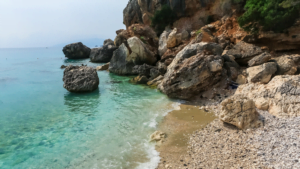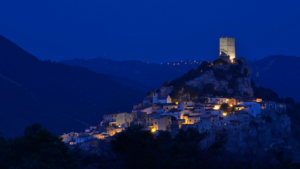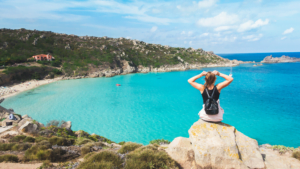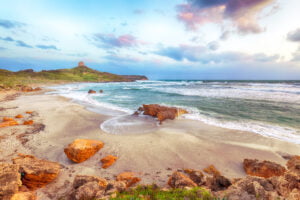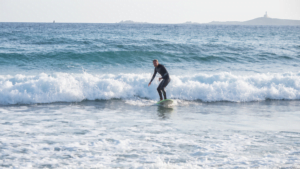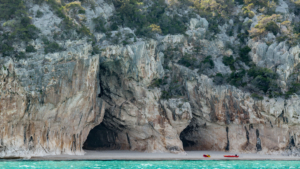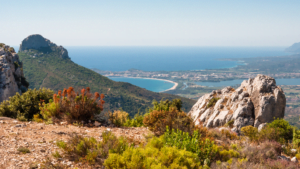While numerous destinations boast beautiful beaches or historical sites, few places combine these with a vibrant local culture and culinary scene that invites visitors to truly engage with the place.
Welcome to Cagliari, the captivating capital of Sardinia, where your search ends. Nestled in the heart of the Mediterranean, Cagliari is a treasure trove of experiences, seamlessly blending ancient history with stunning natural landscapes and a rich culinary heritage. From the winding alleys of its historic districts to the serene beauty of its white-sand beaches and the unparalleled flavors of its local cuisine, Cagliari offers a year-round destination that promises a journey of discovery and delight for all who visit.
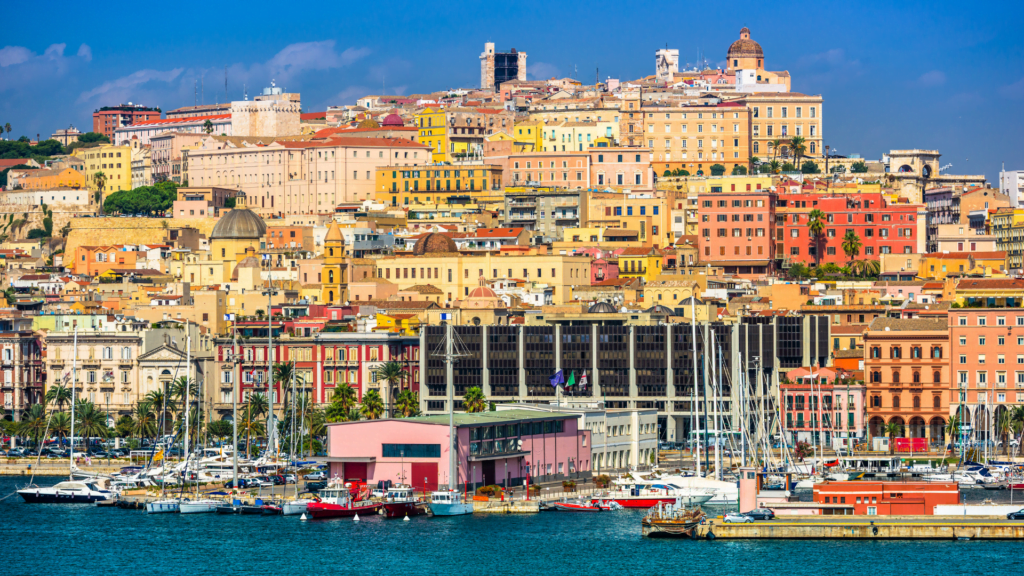
Whether you’re here to explore the remnants of ancient civilizations, bask in the natural wonders, or indulge in the gastronomic delights, Cagliari is the embodiment of a Mediterranean paradise, waiting to be explored.
Things to do in Cagliari
Eploring Cagliari’s Vibrant Districts
Cagliari’s charm doesn’t solely rest on its historical and architectural marvels; the city’s districts breathe life into its streets, each telling its own story of tradition and contemporary vitality. Castello, Stampace, Villanova, and Marina are such neighborhoods, each with a unique character and an integral role in the city’s cultural and social fabric.
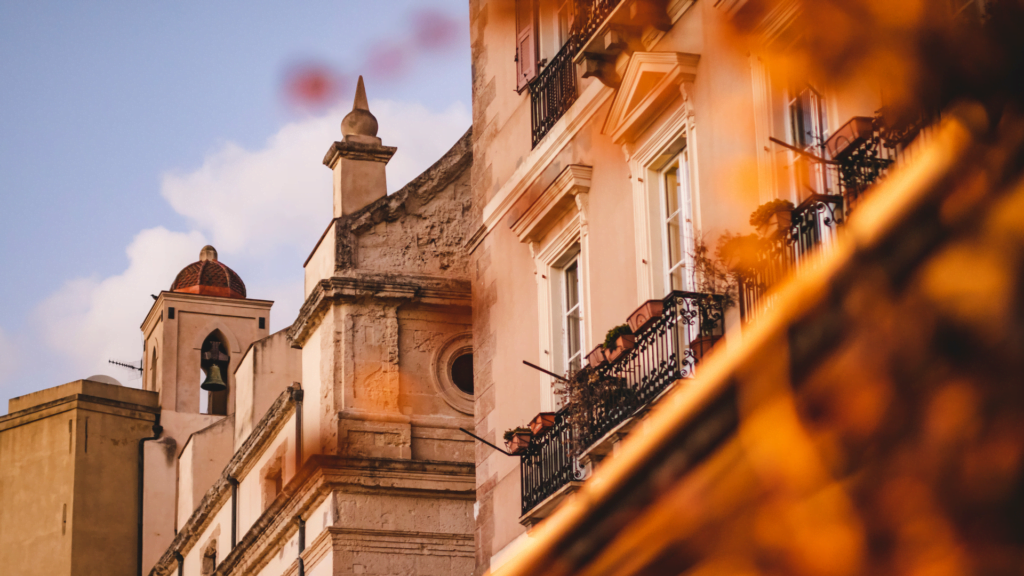

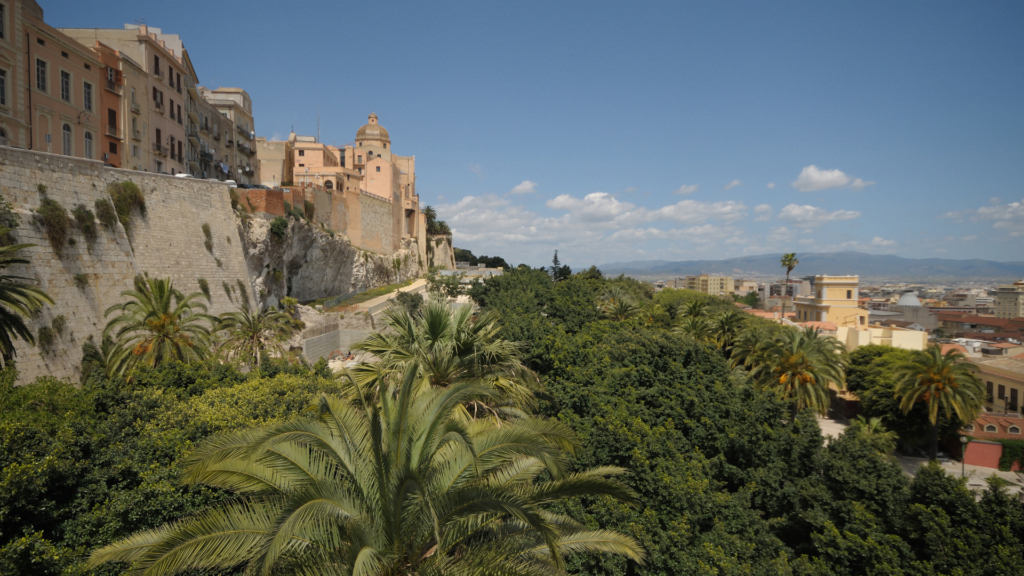

Castello Quarter
The Castello quarter, often considered the heart of Cagliari’s historical center, is perched on a hilltop, offering spectacular views of the city and the sea. It is surrounded by ancient walls that date back to the Pisan and Spanish dominations.
- Watchtowers: The quarter is guarded by two imposing watchtowers, Torre di San Pancrazio and Torre dell’Elefante, built in the 14th century. These towers offer panoramic views and a glimpse into the city’s defensive past.
- The Cathedral: The Cagliari Cathedral, located in the Piazza Palazzo, is a masterpiece of various architectural styles, housing important religious artifacts and artworks.
- Archaeological Museum: The National Archaeological Museum of Cagliari, situated in this quarter, showcases a wide array of artifacts from Sardinia’s ancient Nuragic civilization to the Byzantine era.
- Palazzo Viceregio: Once the residence of the Viceroy during Spanish and Piedmontese rule, this palace is a significant historical site, offering insights into the administrative history of the city.
Stampace: A Glimpse into the Working-Class Soul
- Cultural Heritage: Once the backbone of Cagliari’s working-class community, Stampace retains a rich cultural heritage. This district is a living museum, embodying centuries of ordinary lives intertwined with the city’s broader history.
- Spiritual Landmarks: Stampace is home to significant religious sites, including the Santa Restituta crypt and the Basilica of San Saturnino, one of the city’s oldest churches. Additionally, the Church of Sant’Efisio hosts the annual festival in honor of Saint Efisio, Cagliari’s patron saint, which is a vibrant event drawing visitors from across the globe.
- Community and Tradition: The district’s narrow streets and historic buildings now house a blend of traditional crafts shops, local eateries, and cultural spaces, making it a testament to the enduring spirit of Cagliari’s community.
Villanova: Trendy Lanes and Colorful Life
- Modern Vibrancy: Villanova, once the district of peasants and gardeners, has transformed into one of Cagliari’s most fashionable areas. Its streets, lined with pastel-colored houses and blooming flowers, reflect the district’s lively personality.
- Artistic Flair: Today, Villanova is a hub for artists and entrepreneurs, hosting an array of boutiques, art galleries, and trendy cafes. The district’s transformation is a perfect example of how Cagliari embraces modernity while honoring its roots.
- Social Hub: Villanova’s piazzas and open spaces serve as gathering points for the community and venues for events and markets, contributing to the district’s dynamic social scene.
Marina: Nightlife and Historical Ambiance
- Culinary Scene: Marina district, with its seaside allure, is the epicenter of Cagliari’s culinary scene. From traditional Sardinian restaurants to contemporary dining experiences, the area offers flavors to satisfy every palate.
- Nightlife: As the sun sets, Marina comes alive with its vibrant nightlife. The district’s bars, pubs, and clubs, set against a backdrop of historic buildings, provide a unique setting for evening entertainment.
- Cultural Mix: Marina’s historical ambiance, combined with its contemporary energy, makes it a melting pot of cultures and a reflection of Cagliari’s diverse community. The district’s waterfront promenade, Via Roma, is a favorite spot for both locals and tourists, offering stunning views and a lively atmosphere.
Cagliari’s districts of Stampace, Villanova, and Marina illustrate the city’s ability to weave history with modernity. These neighborhoods, each with their distinct character, contribute to the overall charm and appeal of Cagliari.
Guided Tours


Guided tours in Cagliari are an excellent way to deepen your appreciation for this historic city, offering insights and anecdotes that you might not discover on your own. From the ancient streets of the Castello district to the vibrant colors and tastes of local markets, there’s a guided experience to match every interest.
Historical Walks in Castello


- Castello District Tour: Explore the heart of Cagliari’s old town, where history is etched into every stone and street. A guided walk through Castello can reveal the secrets of the city’s past, from its medieval defense systems to the noble residences. Highlights include visits to the Cathedral of Santa Maria, the Royal Palace (Palazzo Viceregio), and panoramic views from ancient towers.
- Architectural Insights: Learn about the mix of architectural styles that define Castello, from Romanesque to Baroque, and how these reflect the various cultural influences over the centuries.
Specialty Tours


- Cagliari Underground: Venture beneath the city’s surface with a tour of Cagliari’s underground networks, including crypts, cisterns, and air-raid shelters from World War II. These tours reveal a different aspect of the city’s history, hidden from the everyday eye.


- Pink Flamingo Watching: For nature lovers, some tours focus on the natural wonders surrounding Cagliari, including trips to the Molentargius-Saline Natural Park to observe pink flamingos in their natural habitat. These tours can combine birdwatching with educational content about the area’s ecology.
Market Tours


- San Benedetto Market Experience: Dive into the bustling atmosphere of Mercato di San Benedetto, one of the largest covered markets in Europe. A guided tour here offers a sensory journey through stalls piled high with fresh produce, seafood, cheeses, and meats. It’s an opportunity to taste local specialties, learn about Sardinian culinary traditions, and even pick up tips for cooking with island ingredients.


- Street Food Tours: For those looking to sample a variety of local flavors in a short time, a street food tour can be an exciting option. These tours often include stops at historic cafes and hidden eateries in the Marina district, offering a taste of authentic Sardinian street food alongside traditional drinks.


- Wine tour aroud vineyards of Cagliari: Escape the city to explore the vineyards around Cagliari. This tour includes a visit to a traditional winery where you can stroll through the vines, learn about the estate’s history and production, and enjoy a guided wine tasting paired with local specialties. Round-trip transportation ensures a worry-free experience.
Nature and Excursions






- Cagliari Sightseeing Tour: This small-group tour of Cagliari offers a customizable itinerary, allowing you to visit top attractions such as Molentargius Pond, Poetto Beach, and Capo Sant’Elia Lighthouse. Travel comfortably in an air-conditioned vehicle and enjoy personalized attention from your guide, making it a flexible and enjoyable way to explore the city.
- Boat Tour at Devil’s Saddle in Cagliari: Discover the most beautiful bays of Devil’s Saddle on this comfortable boat tour. Departing from the city center, just a 5-minute walk away, professional skippers will guide you to the stunning coves of the Gulf of Cagliari. Relax on board, swim, and snorkel with provided equipment. Explore enchanting bays surrounded by high limestone cliffs, and enjoy a glass of prosecco while listening to stories and legends of Cagliari. Visit secluded corners of the coast that are only accessible by RIB boat.
- Excursion to the Nuraghe Su Nuraxi of Barumini from Cagliari: Journey through the scenic Campidano plain and Marmilla Valley to visit the ancient Nuraghe Su Nuraxi in Barumini. Enjoy a cappuccino in Villamar, admire traditional murals, and explore the fascinating history and architecture of this ancient fortress. The tour also includes a scenic drive through beautiful Sardinian villages.
- You can also find many other tours departing from Cagliari to explore southern and central Sardinia.
Custom and Themed Tours
- Photography Tours: Led by local photographers, these tours are designed to help you capture the beauty of Cagliari, from scenic vistas to intimate street scenes, through the lens.
- Night Tours: Experience Cagliari after dark with a guided night tour, exploring the illuminated streets and landmarks, and perhaps uncovering the city’s ghost stories and legends.
Whether you’re a history buff, food enthusiast, or nature lover, guided tours in Cagliari offer enriching experiences that bring you closer to the essence of the city. These tours not only enhance your understanding of Cagliari’s culture and history but also connect you with local guides who share their love and knowledge of their hometown.
Architectural Gems and Cultural Venues in Cagliari
Cagliari is adorned with numerous architectural gems and cultural venues that highlight the city’s rich history and artistic heritage. Among these, two notable sites stand out for their historical significance and architectural beauty: Santa Croce Church and Palazzo Civico. These landmarks not only offer a glimpse into Cagliari’s past but also serve as active cultural venues that continue to enrich the city’s vibrant life.
Bastione di Saint Remy
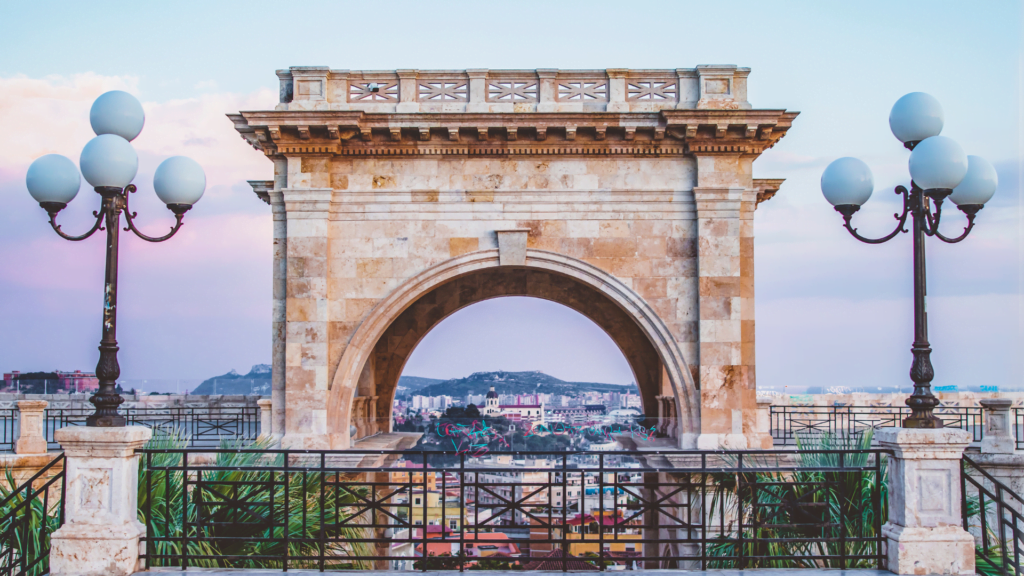

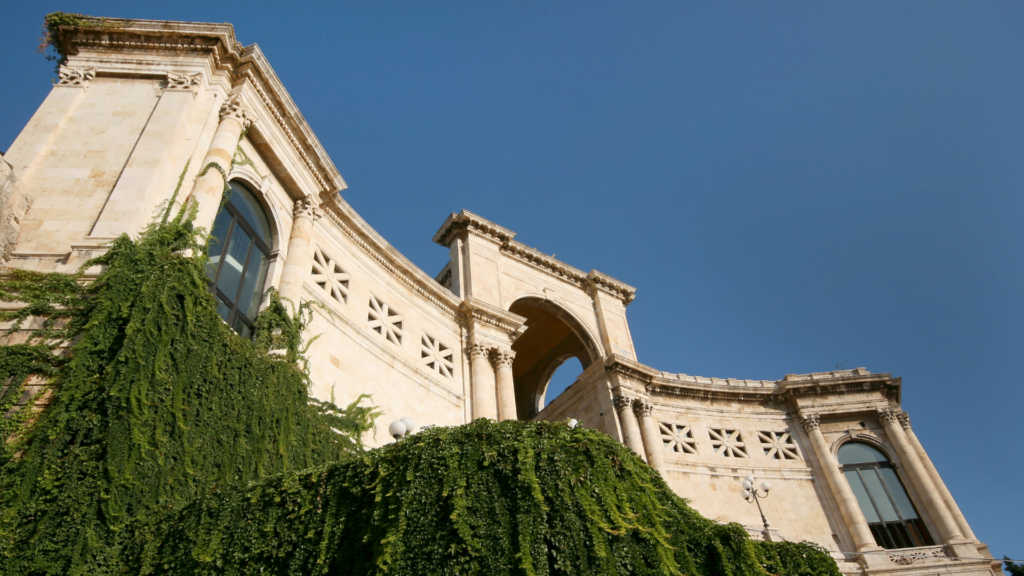

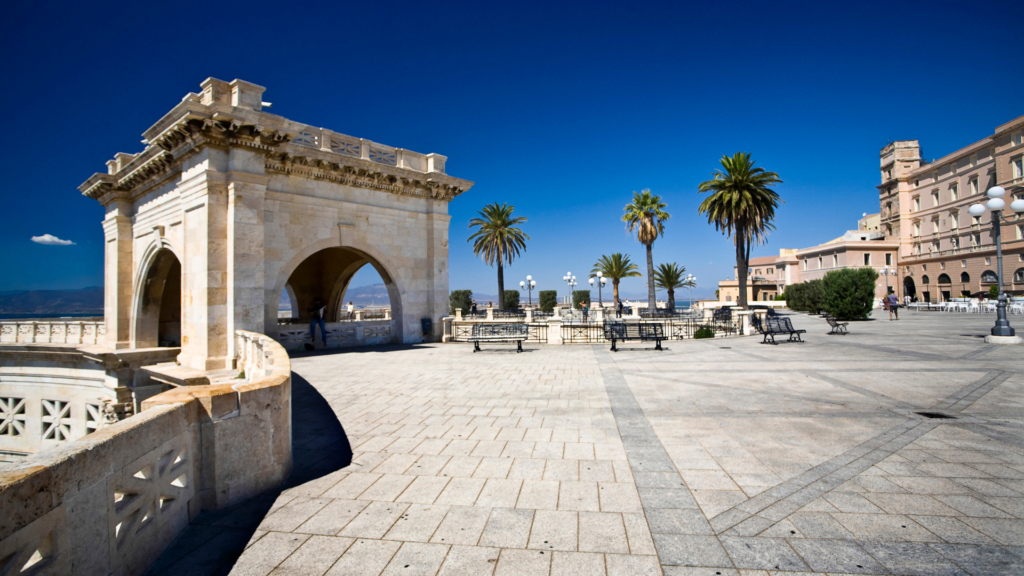

- Icon of Cagliari: The Bastione di Saint Remy is one of Cagliari’s most iconic landmarks, constructed at the end of the 19th century. It stands as a monumental gateway to the Castello district, offering both residents and visitors unparalleled views of the city and the sea.
- Architectural Majesty: This impressive structure is known for its grandeur and architectural beauty, combining elements of classicism and modernity. The Bastione features a large terrace called the Umberto I Terrace, accessible via a grand staircase. The architecture creates a seamless blend with the historic walls of the Castello district, making it a symbol of Cagliari’s rich past and progressive future.
- Cultural and Social Hub: The Bastione di Saint Remy serves as a vibrant cultural and social hub, hosting a variety of events, from exhibitions and concerts to public gatherings. Its spacious terrace and the areas within are often alive with activity, offering a lively space for cultural exchange and entertainment. The panoramic views and the architectural elegance make it a favorite spot for both locals and tourists to enjoy leisurely afternoons and evenings.
This architectural masterpiece not only provides breathtaking views but also hosts cultural events, exhibitions, and concerts, making it a vibrant center of social and cultural activities.
Santa Croce Church
- Historical Significance: Situated in the heart of what was once the Jewish ghetto, Santa Croce Church is a testament to Cagliari’s layered history. This church is unique as it was constructed over a former synagogue following the expulsion of the Jewish community in the late 15th century.
- Architectural Features: While modest in exterior decoration, Santa Croce Church is known for its harmonious blend of Gothic and Baroque elements inside. The interior hosts a variety of artworks, including frescoes and statues, which contribute to its serene and spiritually uplifting atmosphere.
- Cultural Venue: Today, Santa Croce serves not only as a place of worship but also as a site for cultural events and concerts, particularly those that celebrate sacred music. Its historical and cultural significance makes it a compelling stop for visitors interested in the religion and culture of Cagliari.
Cathedral of Santa Maria
Located in the heart of the Castello Quarter, this cathedral in Gothic-Pisan style is a true architectural gem. The interior, richly decorated, houses artworks of invaluable value and an atmosphere of sanctity and peace.
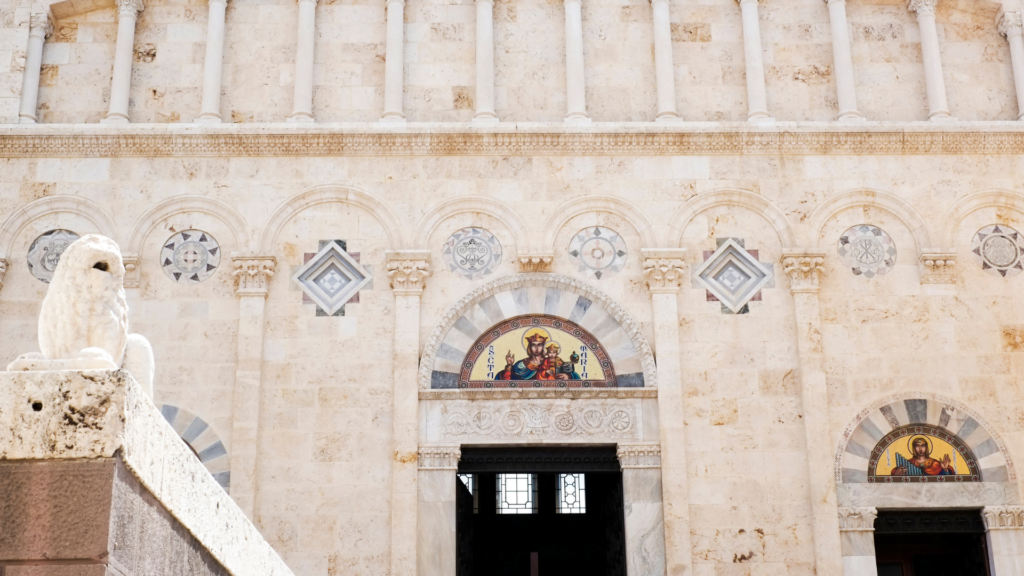

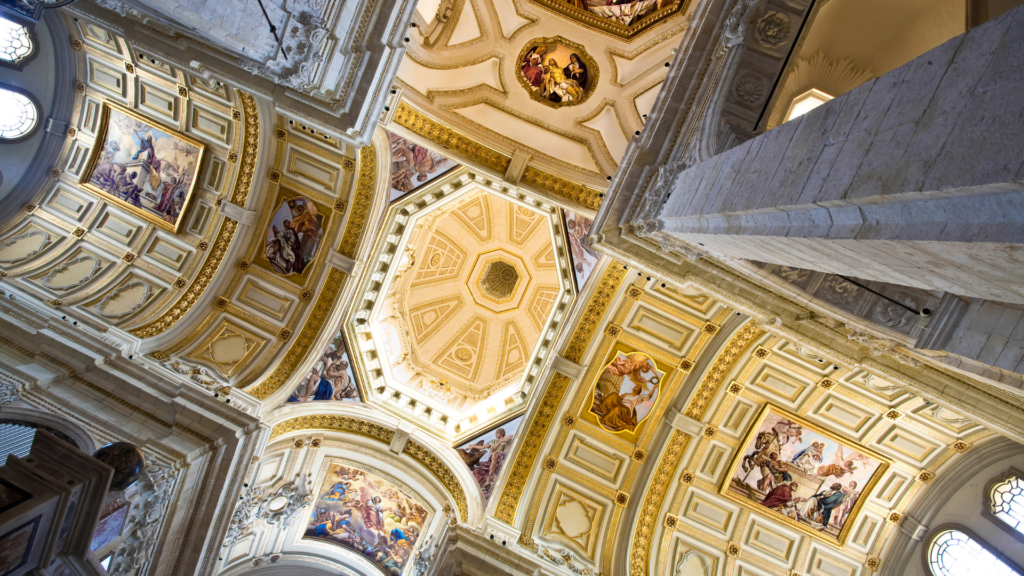
Tower of the Elephant and Tower of San Pancrazio
These imposing medieval towers, built by the Pisans in the 13th century, dominate the landscape of Cagliari. Climbing to the top, one can enjoy breathtaking views of the city and the sea. They are testimonies of the power and importance of Cagliari in the medieval era.
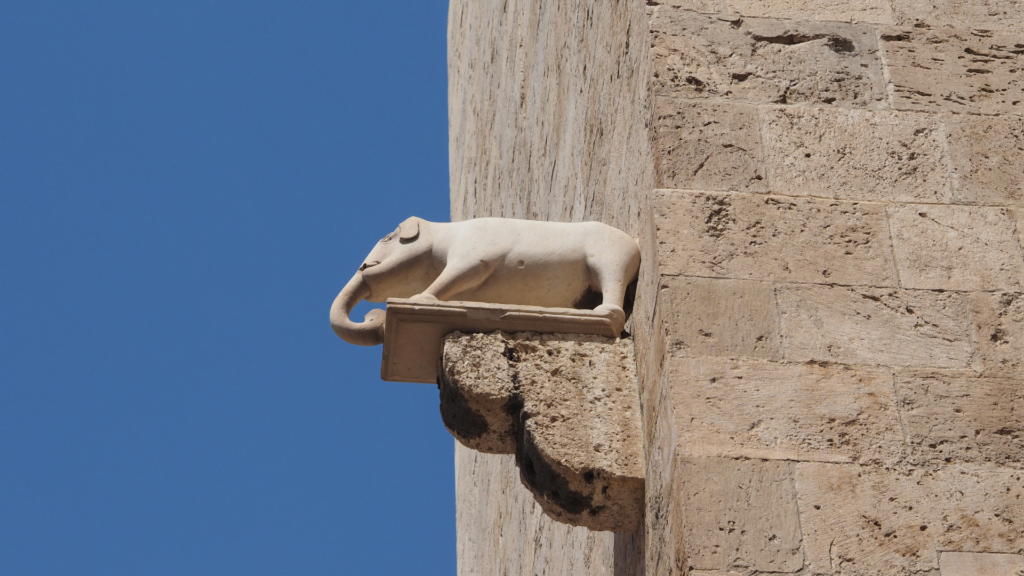

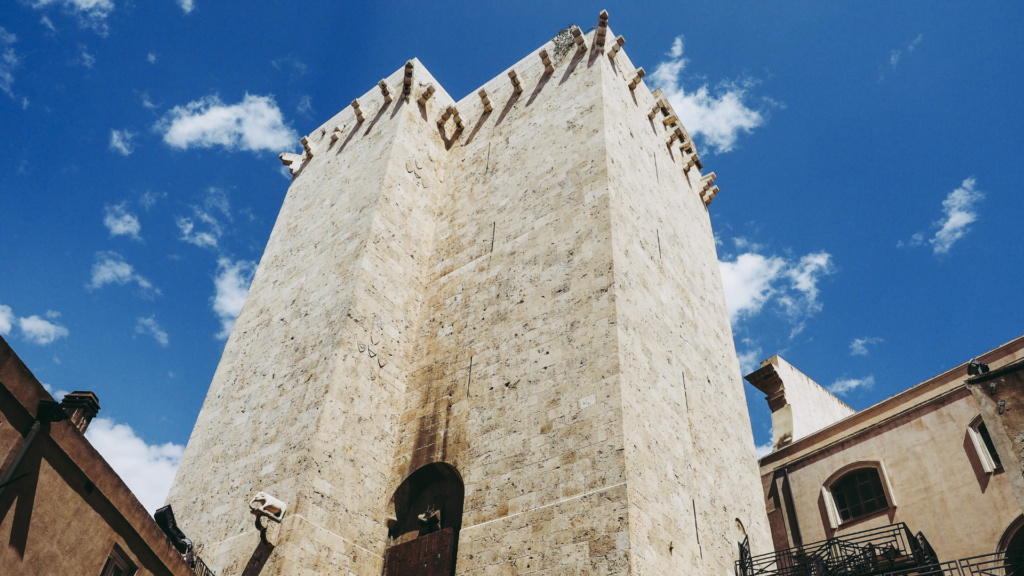

National Archaeological Museum
A journey through the history of Sardinia, from the prehistoric period to late antiquity. The museum houses a vast collection of artifacts, including many objects from the mysterious Nuragic civilization. Check out museums to visit in Cagliari and Sardinia:
Palazzo Civico
- Cagliari’s City Hall: Palazzo Civico, serving as Cagliari’s City Hall, is a splendid example of early 20th-century architecture. It stands as a symbol of the city’s civic pride and governance through the ages.
- Architectural Splendor: The building showcases a facade that is a rich mix of Art Nouveau and Neo-Gothic styles, with intricate decorations, statues, and heraldic symbols that represent the city’s history and cultural identity. Inside, the halls and chambers are equally impressive, adorned with frescoes, sculptures, and elaborate woodwork.
- Public Access and Tours: Palazzo Civico is not only a functioning governmental building but also open to the public through guided tours. These tours offer insights into the building’s architectural features, its role in Cagliari’s governance, and its place in the social and cultural life of the city. Visitors can explore the majestic council chamber, ceremonial rooms, and sometimes, special exhibitions hosted within its walls.
Santa Croce Church and Palazzo Civico are just two of the many architectural and cultural treasures that Cagliari has to offer. Both sites provide a unique window into the city’s past, showcasing the blend of cultures, styles, and stories that have shaped Cagliari over the centuries. Visiting these landmarks offers an enriching experience, deepening one’s appreciation for the art, history, and cultural vibrancy of this Mediterranean jewel.
Archaeological Adventures


Cagliari, with its deep historical roots and layers of past civilizations, offers a treasure trove of archaeological sites that beckon exploration. Among these, the Roman amphitheater and the intriguing underground passageways provide a captivating glimpse into the ancient world.
The Roman Amphitheater
- A Testament to Roman Engineering: Carved directly into the side of a hill during the 2nd century AD, Cagliari’s Roman amphitheater remains a striking example of Roman architectural ingenuity. This ancient structure could seat up to 10,000 spectators, hosting gladiatorial battles and public spectacles.
- Preservation of History: Despite the ravages of time, significant portions of the amphitheater have survived, allowing visitors to walk through the same entrances once used by ancient Romans. The site’s ongoing preservation efforts aim to protect this important piece of Cagliari’s heritage for future generations.
- Cultural Venue: Today, the amphitheater occasionally serves as a unique venue for concerts and cultural events, offering a once-in-a-lifetime experience to see performances in a setting that has echoed with the sounds of history for nearly two millennia.
Cagliari’s Underground
- A Labyrinth Below the City: Cagliari’s history isn’t just found above ground. Beneath the city streets lies a network of crypts, caves, and tunnels that offer a mysterious glimpse into the past. From early Christian crypts to WWII air-raid shelters, the underground of Cagliari reveals layers of history stacked deep beneath the modern city.
- Exploring the Hidden Corners: Tours of Cagliari’s underground sites, such as the crypt of Santa Restituta and the San Pancrazio and Sant’Efisio churches, allow visitors to step back in time and explore these hidden treasures. Each site tells a part of Cagliari’s story, from religious practices to survival strategies in times of war.
- Educational Experience: Guided tours of the underground are not only adventures but also educational experiences that provide insights into the historical significance and architectural techniques of the past. These tours often include visits to areas that are not typically accessible to the public, making them a must-do for history buffs and curious explorers alike.
For those drawn to the allure of ancient civilizations and the stories etched in stone and earth, Cagliari offers a fascinating journey into the past. The Roman amphitheater and the city’s underground passageways serve as gateways to understanding the rich history that has shaped this Sardinian capital. Whether standing in the arena where gladiators once battled or navigating the crypts that weave beneath the city, visitors are sure to find themselves captivated by the archaeological adventures that Cagliari has to offer.
Natural Beauty and Outdoor Adventures
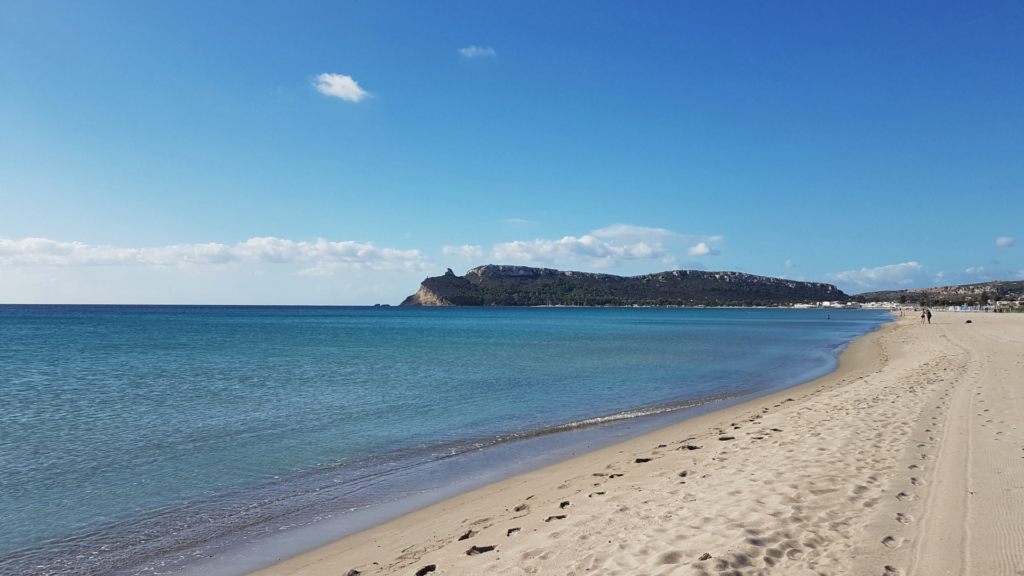

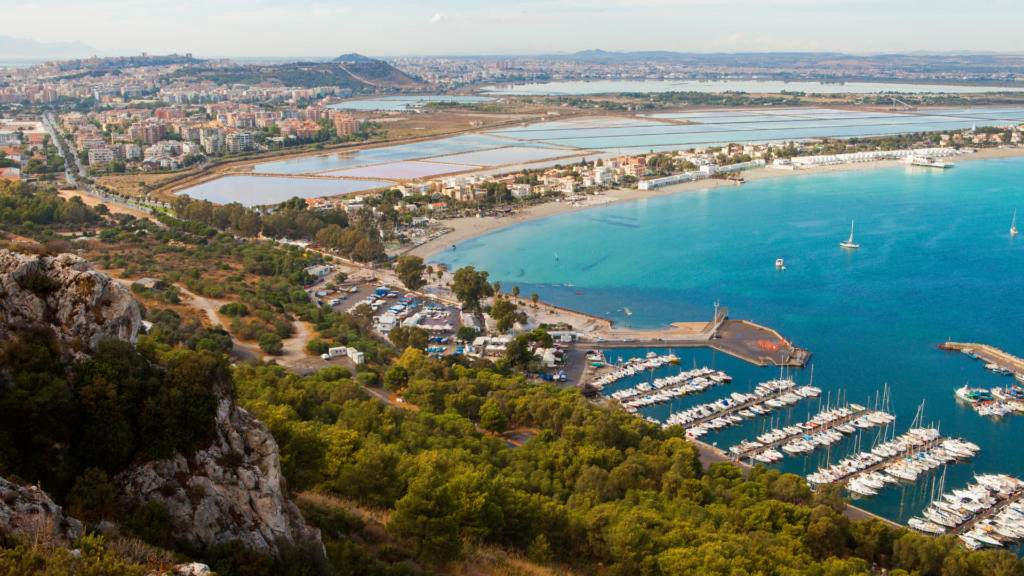

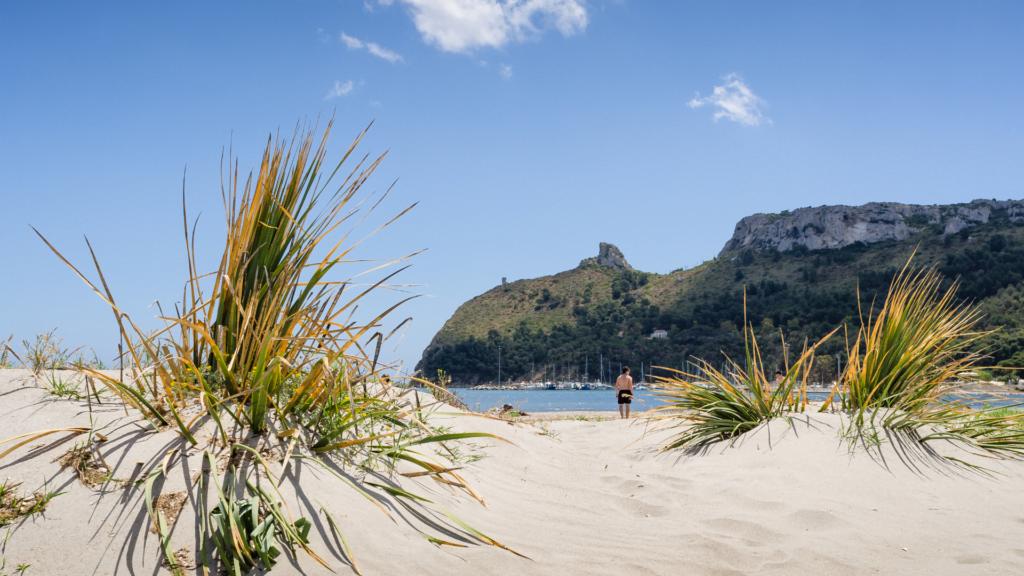

Cagliari, a city rich in history and culture, is equally endowed with natural wonders and opportunities for outdoor adventures. From the sun-kissed beaches to the rugged trails and serene parks, there’s an abundance of ways to connect with nature and enjoy the great outdoors.
Poetto Beach
- Beach Bliss: Poetto Beach is the crown jewel of Cagliari’s coastline, stretching over seven kilometers of fine white sand along the crystal-clear waters of the Mediterranean. It’s not just a beach; it’s a vibrant living space where both locals and visitors come to relax, swim, and engage in various water sports.
- Amenities and Activities: The beach is well-equipped with amenities, including bars, restaurants, and rental services for beach chairs, umbrellas, and water sports equipment. Whether you’re looking to windsurf, kayak, or simply soak up the sun, Poetto has something for everyone.
Sella del Diavolo Hike


- Myth and Landscape: The Sella del Diavolo, or Devil’s Saddle, offers one of the most iconic hikes in the region. This distinctive promontory not only provides a stunning backdrop to Poetto beach but is steeped in legend, adding a mystical allure to your hike.
- Panoramic Views: The trails leading up to the summit of Sella del Diavolo are accessible to hikers of all levels and reward adventurers with breathtaking views of Cagliari and the Mediterranean Sea. It’s an ideal spot for capturing unforgettable moments against the beauty of nature.
Parks
- Monte Urpinu: One of Cagliari’s largest and most beloved parks, Monte Urpinu offers a peaceful retreat with its lush landscapes, walking paths, and panoramic viewpoints. The park is a favorite among families, joggers, and anyone looking to escape the city’s hustle and bustle.
- Monte Claro: Covering 25 hectares, Monte Claro Park is a green sanctuary within the city. With its wide avenues lined with trees, open meadows, and thematic gardens, the park serves as a venue for leisure, cultural events, and educational activities.
- Orto Botanico: Cagliari’s Botanical Garden, is a lush oasis in the heart of the city. Covering approximately five hectares, this garden is not only a place of beauty but also a center for scientific research affiliated with the University of Cagliari.Home to over 2,000 species of plants, the Orto Botanico showcases a rich variety of flora, including both native Sardinian species and exotic plants from around the world. The garden is dedicated to the conservation of rare and endangered species, serving as a living library of biodiversity.
Molentargius Saline Regional Park: A Birdwatcher’s Paradise


- Flamingo Watching: The Molentargius Saline Regional Park is an exceptional natural reserve, especially renowned for its population of pink flamingos. These majestic birds, along with numerous other species, can be observed in their natural environment, offering a unique wildlife watching experience.
- Eco-Tourism: Beyond birdwatching, the park provides excellent opportunities for cycling, walking, and guided tours, allowing visitors to explore its rich ecosystems and learn about the importance of wetland conservation.
Cagliari’s natural and outdoor offerings make it a perfect destination for those who seek the beauty and adventure of the Mediterranean outdoors. Whether you’re lounging on the beach, exploring rugged trails, finding serenity in urban parks, or marveling at wildlife, Cagliari invites you to bask in its natural wonders and embrace the spirit of outdoor adventure.
Culinary Journey Through Cagliari


Embarking on a culinary journey through Cagliari is an exploration of Sardinia’s soul, where each dish tells a story of the island’s history, culture, and the bountiful Mediterranean landscape. Cagliari, as the capital, is a melting pot of all the island’s culinary traditions, offering an unparalleled opportunity to savor authentic Sardinian cuisine.
Discovering Sardinian Flavors
- Local Ingredients: The cornerstone of Sardinian cuisine is its reliance on fresh, locally-sourced ingredients. From the sea, there’s an abundance of fish and seafood, while inland areas provide a variety of meats, particularly lamb, and a plethora of vegetables and herbs, reflecting the island’s pastoral and agricultural traditions.
- Cheese Delights: Cheese plays a pivotal role in Sardinian gastronomy, with pecorino (sheep’s milk cheese) being the most renowned. Visitors can explore various forms of this cheese, from fresh to aged, each with its distinct flavor and texture.
Signature Dishes
- Seafood Galore: Given its coastal location, Cagliari’s cuisine features a rich array of seafood dishes. Highlights include fregola con arselle (a type of pasta served with clams) and bottarga (mullet roe), often grated over pasta or sliced thinly and served with olive oil and lemon.
- Porceddu: No culinary exploration of Cagliari would be complete without tasting porceddu – suckling pig roasted over an open fire, seasoned with local herbs. It’s a traditional dish that embodies the island’s pastoral culture.
- Pane Frattau: A testament to Sardinian ingenuity, this dish layers thin, crispy bread called carasau with tomato sauce, pecorino cheese, and a poached egg, creating a simple yet flavorsome meal.
Market Visits and Cooking Classes
- San Benedetto Market: To truly immerse yourself in Cagliari’s culinary world, a visit to the San Benedetto market is a must. It’s one of the largest covered markets in Europe, offering a dazzling array of fresh produce, meats, cheeses, and seafood. It’s also a place to observe local life and culinary traditions in action.
- Cooking Classes: For those who wish to delve deeper, participating in a cooking class is an enriching experience. Local chefs and culinary experts teach the secrets of Sardinian cooking, from preparing traditional dishes to pairing them with the perfect local wine.
Culinary Tours
- Tasting Experiences: Culinary tours in Cagliari provide a guided tasting journey through the city’s eateries, from high-end restaurants to hidden local gems. These tours often include tastings of street food, such as seadas (a sweet cheese-filled pastry) and culurgiones (stuffed pasta), offering a broad palette of the island’s flavors.
- Wine Tasting: Sardinia’s rich viticulture is showcased in its variety of wines, including the robust Cannonau and the crisp Vermentino. Wine tasting tours introduce enthusiasts to local wineries and vineyards, explaining the winemaking process and the characteristics of each variety.
A culinary journey through Cagliari is an invitation to savor and understand Sardinia through its flavors. It’s an adventure that goes beyond mere tasting, offering insights into the island’s traditions, its land, and its people. Whether you’re exploring local markets, enjoying a meal by the sea, or learning to cook traditional dishes, Cagliari offers a taste of Sardinia that is as rich and varied as the island itself.
San Benedetto Market


Visiting the San Benedetto market in Cagliari is more than just a shopping trip; it’s an immersion into the vibrant heart of Sardinian culture and cuisine. Known as one of the largest covered markets in Europe, San Benedetto is a kaleidoscope of sights, sounds, and smells, offering an authentic slice of local life and an array of the island’s best produce and products.
A Sensory Journey
- Bustling Atmosphere: The lively buzz of San Benedetto market is its signature, with vendors calling out the day’s freshest arrivals and locals mingling and haggling over prices. This bustling atmosphere makes for an energetic and engaging experience.
- Fresh Produce: The market is a showcase for Sardinia’s agricultural bounty. Rows of stalls overflow with fresh fruits and vegetables, featuring both familiar staples and exotic local specialties, reflecting the island’s rich biodiversity.
- Seafood Selection: The seafood section of San Benedetto is a testament to the Mediterranean’s abundance. Shoppers can find everything from daily catches of fish to shellfish and other sea delicacies, all boasting unparalleled freshness.
- Artisanal Goods: Beyond food, the market also features artisanal goods that highlight Sardinian craftsmanship. From handmade cheeses and cured meats to local honey and olive oil, each product tells a story of tradition and expertise.
Culinary Discovery
- Tasting and Learning: Exploring San Benedetto is an opportunity to taste and learn about Sardinian cuisine directly from the source. Vendors often share preparation tips and recipes, offering a deeper understanding of how to use their products in authentic local dishes.
- Gastronomic Inspiration: For food enthusiasts and home cooks, the market is a treasure trove of ingredients that inspire culinary creativity. Discovering new flavors and combinations can lead to exciting gastronomic experiments.
Connecting with Local Culture
- Community Hub: San Benedetto is not just a market; it’s a community hub where locals gather, exchange news, and maintain social connections. Visitors get a glimpse into the everyday life of Cagliari’s residents, making the market experience both personal and profound.
- Sustainable Practices: Shopping at San Benedetto supports local farmers, fishermen, and artisans, promoting sustainable practices and the local economy. It’s an act of participating in and contributing to the preservation of Sardinian culture and heritage.
Tips for Visitors
- Early Visits: To catch the best selection and experience the market at its most lively, it’s recommended to visit in the morning. This is when the products are freshest and the atmosphere is most vibrant.
- Language: While Italian is the main language spoken, many vendors enjoy interacting with visitors and may speak some English. Don’t be shy to ask questions or use gestures; it’s all part of the market experience.
- Sampling: Where possible, take the opportunity to sample products. It’s a great way to discover new flavors and decide what to buy.
A visit to San Benedetto market is a must-do for anyone wanting to experience the real Cagliari. It offers a unique opportunity to explore the culinary riches of Sardinia, connect with local culture, and enjoy the lively atmosphere that defines Mediterranean markets. Whether you’re a food lover, a culinary adventurer, or simply curious, San Benedetto promises a memorable and enriching experience.
Where to Stay in Cagliari
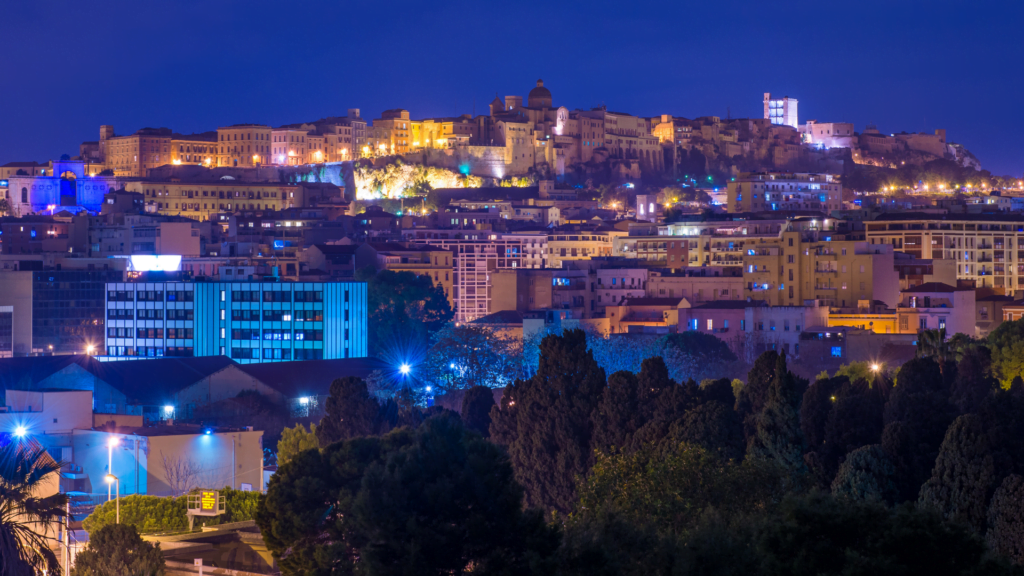

Cagliari offers a wide range of accommodation options to suit all needs and budgets. Here some of the best options in the Sardinian capital:
Palazzo Tirso
If you’re looking for a luxury experience in the heart of Cagliari, Palazzo Tirso is the perfect choice. This hotel is located in a beautifully restored historic building, combining the charm of the old with all modern comforts. Each room is tastefully furnished and attention to detail, creating a welcoming and refined atmosphere. And the location could not be better: Palazzo Tirso is located in the center of Cagliari, just steps away from the main tourist sites.
T Hotel
T Hotel is another excellent luxury hotel in Cagliari. Located near the Teatro Lirico and opposite the Parco della Musica, this hotel is known for its extraordinary wellness center, where you can relax after a day spent exploring the city. The hotel’s lounge bar, with its modern design and wide selection of cocktails, is the perfect place to end the day in style.
Villa Fanny
If you prefer a more intimate atmosphere, Villa Fanny is the hotel for you. This small hotel is located near the University of Cagliari, in a quiet area but convenient for reaching the main tourist sites. Each room is uniquely decorated, with handmade furniture and a captivating design that will make you feel at home.
Hostel Marina
For travelers on a tighter budget, Hostel Marina is an excellent choice. This hostel is located in the lively La Marina district, surrounded by restaurants, pubs, and cafes. The atmosphere is friendly and social, making it the ideal place to meet other travelers and make new friends.
Whether you prefer the luxury of a five-star hotel, the cozy atmosphere of a small hotel, or the liveliness of a hostel, Cagliari has the perfect accommodation for you. So, book your room and get ready to discover everything this charming city has to offer!
Where is Cagliari?
Cagliari is the capital and largest city of the island of Sardinia, Italy. It is located on the south coast of the island, at the northern extremity of the Gulf of Cagliari. Cagliari is the 26th largest city in Italy and has a population of about 155,000 inhabitants, with the metropolitan area including Cagliari and 16 other nearby municipalities totaling around 420,000 inhabitants.
Weather in Cagliari
Cagliari, like the rest of Sardinia, enjoys a Mediterranean climate with hot summers and mild winters.
- Spring (March-May): Temperatures begin to rise, with averages ranging from 15°C to 20°C. This is a great time to visit Cagliari, as the weather is pleasant and tourist crowds are still limited.
- Summer (June-August): Temperatures can exceed 30°C, with high humidity. This is the most popular time to visit the beaches, but it can be very crowded.
- Autumn (September-November): Temperatures begin to drop, with averages ranging from 20°C to 25°C. This is another great time to visit, with fewer tourists and still pleasant weather.
- Winter (December-February): Temperatures can drop to 10°C, but rarely fall below zero. This is the least popular time to visit, but it can still be pleasant if you prefer cooler weather.
These are just averages and temperatures can vary. It is always a good idea to check the weather before your trip to better plan your activities in Cagliari.
To make the most of a day in Cagliari, you can follow this itinerary:
- Start at the Orto Botanico: Begin your day at the botanical garden, Orto Botanico, where you can explore different areas and enjoy a tour. It’s a serene place with an interesting history and beautiful surroundings.
- Visit the Roman Amphitheater: Explore the Roman Amphitheater, a historical site dating back to the 2nd century AD, carved entirely in rock and able to hold up to 10,000 people. It’s a fascinating glimpse into ancient history.
- Discover Villa di Tigellio: Visit Villa di Tigellio, a 1st-century BC villa that was once the residence of poet and musician Tigellio Ermogene. Explore its underground areas for a unique perspective on the city’s history.
- Explore Museo Archeologico Nazionale: Head to the National Archaeological Museum located in Castello to see an exquisite collection of bronzetti and learn about the nuragic civilization of Sardinia.
- Enjoy Picture-Perfect Views: Make your way to Bastione di San Remy for stunning panoramic views overlooking the city. It’s a perfect spot to capture memorable moments and take in the beauty of Cagliari.
- Experience Local Nightlife: Finish your day by immersing yourself in Cagliari’s vibrant nightlife scene. Explore bars and pubs in historic districts like La Marina and Stampace.
By following this itinerary, you can experience a mix of history, culture, nature, and local life in Cagliari within a day.
If you have three days you can take your time to explore Cagliari.
Day 1:
- Morning: Begin your day by exploring the historical Torre dell’Elefante for a glimpse into medieval engineering and history.
- Afternoon: Visit the National Archaeological Museum in Castello to learn about the nuragic civilization of Sardinia.
- Evening: Head to the Bastione di San Remy in Piazza Costituzione, a symbol of Cagliari, for panoramic views and a glimpse into the city’s architectural heritage.
Day 2:
- Morning: Explore the winding streets of the old town and soak in the unique charm of Cagliari.
- Afternoon: Discover the Roman Amphitheater, a fascinating historical site dating back to the 2nd century AD.
- Evening: Immerse yourself in Cagliari’s vibrant nightlife scene by visiting bars and pubs in historic districts like La Marina and Stampace.
Day 3:
- Morning: Start your day at the Giardini Pubblici (Public Gardens) located at Largo Giuseppe Dessì for a relaxing stroll amidst nature.
- Afternoon: Visit the Orto Botanico di Cagliari (Botanical Garden of Cagliari) on Via Sant’Ignazio da Laconi to explore a variety of plant species and enjoy the peaceful surroundings.
- Evening: Conclude your day by visiting the Torre di San Pancrazio at Piazza dell’Indipendenza for panoramic views of the city and a glimpse into its historical architecture.
If you want you can also add (or swap) other activities as seen in this guide.


